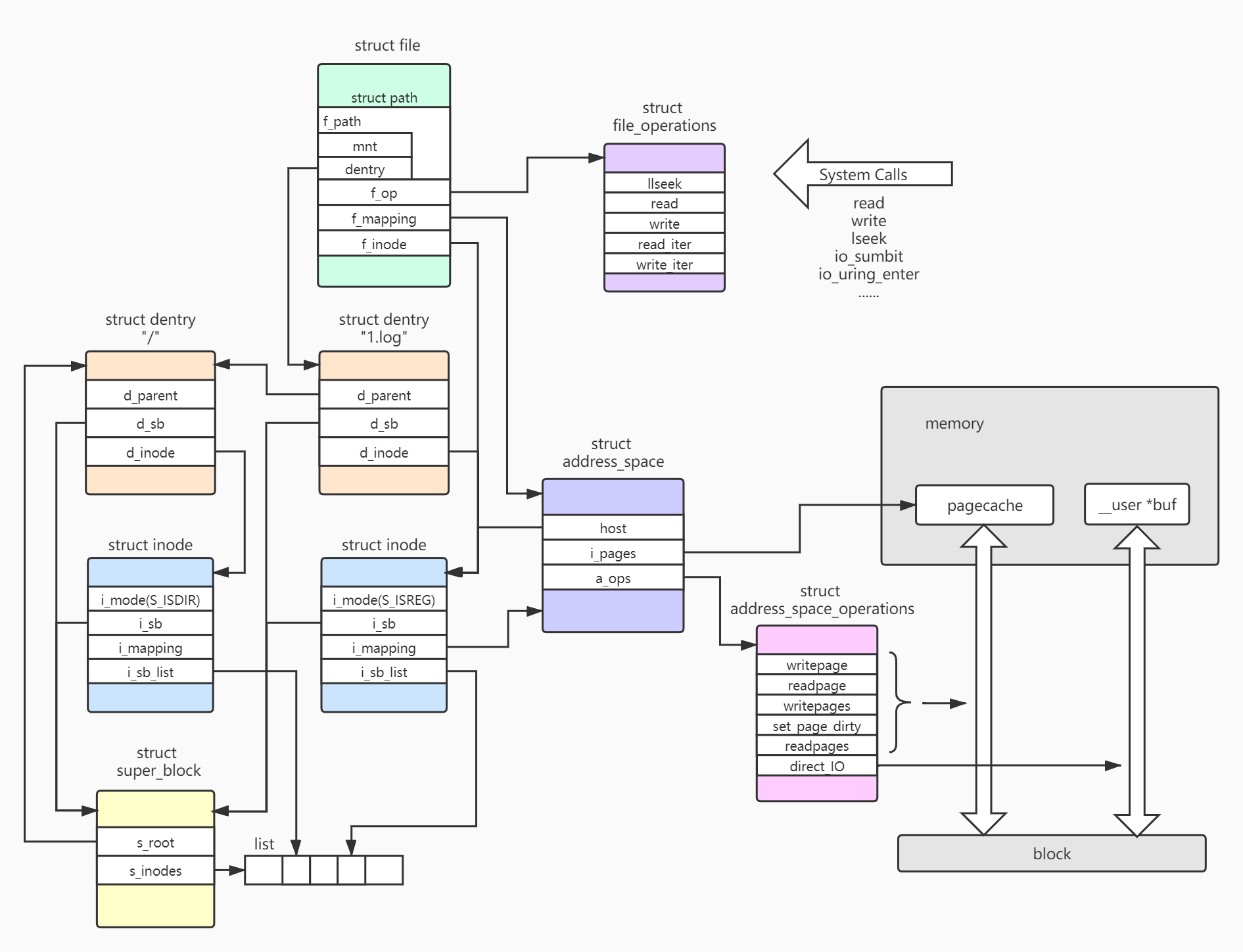VFS
概念
虚拟文件系统(也称为虚拟文件系统交换机)是内核中的软件层,为用户空间程序提供文件系统接口。它还在内核中提供了一个抽象,允许不同的文件系统实现共存
"一切皆文件"是Linux的基本哲学之一,不仅是普通的文件,包括目录、字符设备、块设备、套接字等,都可以以文件的方式被对待。实现这一行为的基础,正是Linux的虚拟文件系统机制。。
还记得系统调用吧?你可以VFS类似给各种文件系统抽象出来了一个系统调用,把各种类型的文件系统封装成对上层不可见的,同时留出一些api。示意图如下

VFS设计
Linux为了实现这种VFS系统,采用面向对象的设计思路,主要抽象了四种对象类型:
- 超级块对象:代表一个已安装的文件系统。 (struct super_block)
- 索引节点对象:代表具体的文件。 (struct inode)
- 目录项对象:代表一个目录项,是文件路径的一个组成部分。 (struct denrtry)
- 文件对象:代表进程打开的文件。 (struct file)
容易混淆的地方
Linux将目录当做文件对象来处理,是另一种形式的文件,它里面包含了一个或多个目录项。而目录项是单独抽象的对象,主要包括文件名和索引节点号。因为目录是可以层层嵌套,以形成文件路径,而路径中的每一部分,其实就是目录项。
struct super_block (代表一个已安装的文件系统)
include/linux/fs.h
超级块代表的是一种文件系统类型,比如ext3、ext4都有对应的super_block结构体。一台机器可以有多块硬盘,一个硬盘可以有多个分区,每个分区都有自己的文件系统类型,超级块同时也维护跟这个文件系统有关的各种信息。 各个super_block由链表组织
struct super_block {
struct list_head s_list; //通过该变量链接到超级块全局链表super_blocks上
dev_t s_dev; //该文件系统对应的块设备标识符
unsigned char s_blocksize_bits;
unsigned long s_blocksize; //该文件系统的block size
loff_t s_maxbytes; //文件系统支持的最大文件
struct file_system_type *s_type; //文件系统类型,比如ext3、ext4
const struct super_operations *s_op; //超级块的操作函数
const struct dquot_operations *dq_op; //文件系统限额相关操作
const struct quotactl_ops *s_qcop; //磁盘限额
const struct export_operations *s_export_op;
unsigned long s_flags; //文件系统的mount标记
unsigned long s_iflags; /* internal SB_I_* flags */
unsigned long s_magic; //该文件系统类型的魔术字
struct dentry *s_root; //全局根目录的dentry项
...
struct block_device *s_bdev; //对应的块设备
struct backing_dev_info *s_bdi; //超级块对应的BDI设备
struct mtd_info *s_mtd;
//通过该变量,链接到file_system_type中的fs_supers链表
struct hlist_node s_instances;
...
char s_id[32]; /* Informational name */
uuid_t s_uuid; /* UUID tune2fs -l可以查看*/
void *s_fs_info; //指向具体文件系统超级块结构,如ext4_sb_info
...
const struct dentry_operations *s_d_op; //该超级块默认的目录项操作函数
...
struct shrinker s_shrink; //每个超级块注册的shrink函数,用于内存回收
...
/* AIO completions deferred from interrupt context */
struct workqueue_struct *s_dio_done_wq;
...
//该超级块对应的未在使用dentry列表
struct list_lru s_dentry_lru ____cacheline_aligned_in_smp;
//该超级块对应的未在使用inode列表
struct list_lru s_inode_lru ____cacheline_aligned_in_smp;
...
/* s_inode_list_lock protects s_inodes */
spinlock_t s_inode_list_lock ____cacheline_aligned_in_smp;
struct list_head s_inodes; //该超级块包含的所有inode
spinlock_t s_inode_wblist_lock;
struct list_head s_inodes_wb; //该超级块正在回写的inode
};
ps:超级块的信息是可读的!通过cat 某个文件可以human readab。具体是哪个我忘了。。。在油管一个视频上看到的
const struct dentry_operations *s_d_op 存放着文件系统的目录项操作函数(函数指针)
struct file_system_type
超级块是实装的文件系统,file_system_type专注于描述这个这个文件系统的类型,由链表组织
每种文件系统都要把自己的信息挂到super_blocks这么一个全局链表上
file_system_type挂载到super_block
内核中是分成2个步骤完成:
首先每个文件系统必须通过register_filesystem函数将自己的file_system_type挂接到file_systems这个全局变量上,
然后调用kern_mount函数把自己的文件相关操作函数集合表挂到super_blocks上。每种文件系统类型的读超级块的例程(get_sb)必须由自己实现。
struct file_system_type {
const char *name; //文件系统名称,如ext4,xfs
...
struct dentry *(*mount) (struct file_system_type *, int,
const char *, void *); //对应的mount函数
void (*kill_sb) (struct super_block *);
struct module *owner;
struct file_system_type * next; //通过该变量将系统上所有文件系统类型链接到一起
struct hlist_head fs_supers; //该文件系统类型锁包含的超级块对象
...
};
struct inode (物理Device storage的具体对象)
当创建一个文件的时候,就给文件分配了一个inode。一个inode只对应一个实际文件,一个文件也会只有一个inode。inodes最大数量就是文件的最大数量。
inode结构中的静态信息取自物理设备上的文件系统,由文件系统指定的函数填写,它只存在于内存中,可以通过inode缓存访问。
struct inode {
struct list_headi_hash;
struct list_headi_list;
struct list_headi_dentry;
struct list_headi_dirty_buffers;
unsigned longi_ino; /*每一个inode都有一个序号,经由super block结构和其序号,我们可以很轻易的找到这个inode。*/
atomic_t i_count; /*在Kernel里,很多的结构都会记录其reference count,以确保如果某个结构正在使用,它不会被不小心释放掉,i_count就是其reference count。*/
kdev_t i_dev; /* inode所在的device代码 */
umode_t i_mode; /* inode的权限 */
nlink_t i_nlink; /* hard link的个数 */
uid_t i_uid; /* inode拥有者的id */
gid_t i_gid; /* inode所属的群组id */
kdev_t i_rdev; /* 如果inode代表的是device的话,那此字段将记录device的代码 */
off_t i_size; /* inode所代表的档案大小 */
time_t i_atime; /* inode最近一次的存取时间 */
time_t i_mtime; /* inode最近一次的修改时间 */
time_t i_ctime; /* inode的产生时间 */
unsigned long i_blksize; /* inode在做IO时的区块大小 */
unsigned long i_blocks; /* inode所使用的block数,一个block为512 byte*/
unsigned long i_version; /* 版本号码 */
unsigned short i_bytes;
struct semaphore i_sem;
struct rw_semaphore i_truncate_sem;
struct semaphore i_zombie;
struct inode_operations *i_op;
struct file_operations *i_fop;/* former ->i_op->default_file_ops */
struct super_block *i_sb; /* inode所属档案系统的super block */
wait_queue_head_t i_wait;
struct file_lock *i_flock; /* 用来做file lock */
struct address_space *i_mapping;
struct address_space i_data;
struct dquot *i_dquot [MAXQUOTAS];
/* These three should probably be a union */
struct pipe_inode_info *i_pipe;
struct block_device *i_bdev;
struct char_device *i_cdev;
unsigned longi_dnotify_mask; /* Directory notify events */
struct dnotify_struct *i_dnotify; /* for directory notifications */
unsigned long i_state; /* inode目前的状态,可以是I_DIRTY,I_LOCK和 I_FREEING的OR组合 */
unsigned int i_flags; /* 记录此inode的参数 */
unsigned char i_sock; /* 用来记录此inode是否为socket */
atomic_t i_write count;
unsigned int i_attr_flags; /* 用来记录此inode的属性参数 */
__u32 i_generation;
union {
struct minix_inode_info minix_i;
struct ext2_inode_info ext2_i;
struct ext3_inode_info ext3_i;
struct hpfs_inode_info hpfs_i;
struct ntfs_inode_info ntfs_i;
struct msdos_inode_info msdos_i;
struct umsdos_inode_info umsdos_i;
struct iso_inode_info isofs_i;
struct sysv_inode_info sysv_i;
struct affs_inode_info affs_i;
struct ufs_inode_info ufs_i;
struct efs_inode_info efs_i;
struct romfs_inode_info romfs_i;
struct shmem_inode_info shmem_i;
struct coda_inode_info coda_i;
struct smb_inode_info smbfs_i;
struct hfs_inode_info hfs_i;
struct adfs_inode_info adfs_i;
struct qnx4_inode_info qnx4_i;
struct reiserfs_inode_info reiserfs_i;
struct bfs_inode_info bfs_i;
struct udf_inode_info udf_i;
struct ncp_inode_info ncpfs_i;
struct proc_inode_info proc_i;
struct socketsocket_i;
struct usbdev_inode_info usbdev_i;
struct jffs2_inode_infojffs2_i;
void *generic_ip;
} u;
};
虽然每个文件都有相应的inode结点,但是只有在需要的时候系统才会在内存中为其建立相应的inode数据结构,建立的inode结构将形成一个链表,我们可以通过遍历这个链表去得到我们需要的文件结点,
struct dentry (主存中的一个实体)
为什么引入dentry
引入目录项结构是很有必要的,因为同一个文件有且仅有一个inode对象表示,而由于硬链接的存在,对同一文件的访问可以通过不同的文件名,所以中间需要引入目录项
struct dentry {
atomic_t d_count; /* 目录项对象引用计数器 */
unsigned int d_flags; /* 目录项高速缓存标志 */
spinlock_t d_lock; /* 保护目录项对象的自旋锁 */
struct inode *d_inode; /* 与文件名关联的索引节点 */
struct hlist_node d_hash; /* 指向散列表表项链表的指针 */
struct dentry *d_parent; /* 父目录的目录项对象 */
struct qstr d_name; /* 文件名 */
struct list_head d_lru; /* 用于未使用目录项链表的指针 */
union {
struct list_head d_child; /* 对目录而言,用于同一父目录中的目录项链表的指针 */
struct rcu_head d_rcu; /* 回收目录项对象时,由RCU描述符使用 */
} d_u;
struct list_head d_subdirs; /* 对目录而言,子目录项链表的头 */
struct list_head d_alias; /* 用于与同一索引节点(别名)相关的目录项链表的指针 */
unsigned long d_time; /* 由d_revalidate方法使用 */
struct dentry_operations *d_op; /* 目录项方法 */
struct super_block *d_sb; /* 文件的超级块对象 */
void *d_fsdata; /* 依赖于文件系统的数据 */
struct dcookie_struct *d_cookie;/* 指向内核配置文件使用的数据结构的指针 */
int d_mounted; /* 对目录项而言,用于记录安装该目录项的文件系统数的计数器 */
unsigned char d_iname[DNAME_INLINE_LEN_MIN]; /* 存放短文件名的空间 */
};
目录项的三种状态
1.正在使用 d_count > 0
2.未被使用 d_count == 0
3.负状态 d_inode == NULL 目录项对象没有对应的有效索引节点
struct file (被打开的文件对象)
include/Linux/fs.h
文件结构体代表一个打开的文件,系统中的每个打开的文件在内核空间都有一个关联的 struct file。它由内核在打开文件时创建,并传递给在文件上进行操作的任何函数。在文件的所有实例都关闭后,内核释放这个数据结构。在内核创建和驱动源码中,struct file的指针通常被命名为file或filp
struct file {
union {
struct list_head fu_list; //文件对象链表指针linux/include/linux/list.h
struct rcu_head fu_rcuhead; //RCU(Read-Copy Update)是Linux 2.6内核中新的锁机制
} f_u;
struct path f_path; //包含dentry和mnt两个成员,用于确定文件路径
#define f_dentry f_path.dentry //f_path的成员之一,当前文件的dentry结构
#define f_vfsmnt f_path.mnt //表示当前文件所在文件系统的挂载根目录
const struct file_operations *f_op; //与该文件相关联的操作函数
atomic_t f_count; //文件的引用计数(有多少进程打开该文件)
unsigned int f_flags; //对应于open时指定的flag
mode_t f_mode; //读写模式:open的mod_t mode参数
loff_t f_pos;//当前文件指针位置
off_t f_pos; //该文件在当前进程中的文件偏移量
struct fown_struct f_owner; //该结构的作用是通过信号进行I/O时间通知的数据。
unsigned int f_uid, f_gid;// 文件所有者id,所有者组id
struct file_ra_state f_ra; //在linux/include/linux/fs.h中定义,文件预读相关
unsigned long f_version;//记录文件的版本号,每次使用之后递增
#ifdef CONFIG_SECURITY
void *f_security;
#endif
/* needed for tty driver, and maybe others */
void *private_data;//使用这个成员来指向分配的数据
#ifdef CONFIG_EPOLL
/* Used by fs/eventpoll.c to link all the hooks to this file */
struct list_head f_ep_links;
spinlock_t f_ep_lock;
#endif /* #ifdef CONFIG_EPOLL */
struct address_space *f_mapping;
};
dentry与inode
inode(可理解为ext2 inode)对应于物理磁盘上的具体对象,dentry是一个内存实体,其中的d_inode成员指向对应的inode。也就是说,一个inode可以在运行的时候链接多个dentry,而d_count记录了这个链接的数量。
按照d_count的值,dentry分为以下三种状态:
1.正在使用 d_count > 0
2.未被使用 d_count == 0
3.负状态 d_inode == NULL 目录项对象没有对应的有效索引节点
File_system_type -->file_system —>super_block关系图 
VFS中各个重要数据结构关系图























 1215
1215











 被折叠的 条评论
为什么被折叠?
被折叠的 条评论
为什么被折叠?










